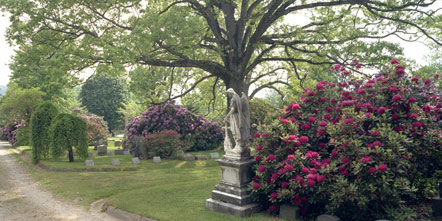
Greendale Cemetery
Meadville, Pennsylvania
Rhododendron Collection Meadville, Pennsylvania
history continued
In 1875, Herman Munz, a landscape gardener and horticulturist, was engaged as the cemetery's third Superintendent. Munz was charged with improving and planting the grounds. During Munz’s tenure, hundreds of flowering shrubs and trees, including oaks, were planted. Today, the 200-acre cemetery is home to over 1500 Rhododendrons (predominantly Rhododendron catawbiense), the largest of these, some 125 years old, is 35 feet tall and 28 feet in diameter. A great number of these surviving Rhododendrons are the result of Munz's efforts.
In 1977, the September issue of American Nurseryman magazine cited the cemetery’s collection of plantings as outstanding specimens. The magazine featured one of Greendale’s Rhododendrons (Album elegans) on the cover showing its tremendous size even then. The magazine reported that the specimen was likely more than seventy five years old and that is was twenty-four feet wide and eighteen feet tall. Today, the cemetery landscape continues to offer a diverse scenographic experience for visitors, including the deep ravine that runs through the cemetery. The picturesque paths that wind through the ravine allow visitors a glimpse of virgin growth hardwoods and ancient hemlock trees in a near natural state. The ravine's streambed has also yielded significant fossil remains.
Greendale Cemetery remains an important example of the Rural Cemetery style. The majesty of the Rhododendrons reign over the generations buried within the cemetery's gates and provide comforting beauty to visitors.
